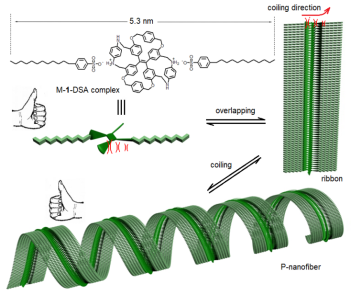Recently, the research group led by Prof. Zheng Yansong published a paper entitled “The largest CPL enhancement by further assembly of self-assembled superhelices based on the helical TPE macrocycle” (10.1039/D0MH01303J) on Materials Horizons to share their research achievements in the development of circularly polarized luminescence using chiral AIE molecule. This represents the new progress made by the group in this field, subsequent to the paper "Chiral recognition and enantiomer excess determination based on emission wavelength change of AIEgen rotor" (doi.org/10.1038/s41467-019-13955-z) published on Nat. Commun. And the paper “Chiral AIEgens - Chiral Recognition, CPL Materials and Other Chiral Applications” (doi.org/10.1016/j.ccr.2020.213329) on Coord. Chem. Rev. in this year.
Just imagine when you use your mobile phone to watch an athlete kicking a ball, you will feel that the football flies out of the screen and comes straight to your head which is quite exciting. This is the 3D display in the future, which can be realized by the organic compounds that can emit CPL fluorescence. Excellent CPL-active materials are mainly judged by their CPL dissymmetry factor and fluorescence quantum yield. However, for chiral organic fluorophores, glum is generally in the range of 10-5 to10-3, which is far less than the theoretical maximum value. For enlarging the CPL glum value, the most crucial method is to make the organic fluorophores assemble into ordered aggregates, especially helical nanofibers, which can significantly amplify the chiroptical dissymmetry. But generally, the dissymmetry can only reach 10-2.
In this research, helical tetraphenylethylene (TPE) tetracycle tetramine enantiomers were synthesized and showed CPL activity with glum at the 10−3 level. After the helical enantiomer self-assembled into superhelices together with 4-dodecylbenzenesulfonic acid, the CPL signal was enhanced by more than 60-fold both in solution and in the solid state. Unprecedentedly, the superhelices could further self-assemble together with one enantiomer of tartaric acid (TA) to become longer and wider bundles, which showed a CPL |glum| of up to 0.61 and gave the largest CPL enhancement (more than 200-fold) among CPL active materials. But another TA enantiomer aroused no CPL change, showing great potential for chiral recognition of conventional chiral molecules through the CPL spectrum. Moreover, due to the phenyl tilt of the TPE unit, the helical sense of the superhelices is opposite to that of the helical monomer, which was confirmed by theoretical calculations. Meanwhile, thanks to the AIE character of the TPE unit and complete immobilization of its propeller-like conformation, the helical nanofibers displayed a Φf of 95%. This finding demonstrates that the CPL dissymmetry factor can be consecutively magnified by formation of superhelices and further assembly of helical self-assemblies, providing a new method for preparing highly active CPL materials.

This is the first example of using secondary self-assembly, especially by making helical nanofibers further assemble, to significantly enhance the CPL intensity. Given that many helical molecules such as helicenes and a large number of superhelices emit weak CPL signals, this finding provides a new approach to CPL materials with excellent performance by making use of successive assembly of helical molecules and even superhelices.
This research is funded by the National Natural Science Foundation of China's major research plan for the precise construction of multi-level chiral materials and a general project (91856125, 21673089 and 22072050). Dr. Yuan Yingxue is the first author and Prof. Zheng Yansong is the corresponding author. The co-authors are Dr. Hu Ming, Zhang Kairan, Zhou Tingting, as well as Prof. Liu Minghua and Dr. Wang Song from the Institute of Chemistry of Chinese Academy of Sciences.
Link of the paper: https://doi.org/10.1039/D0MH01303J